Botanical Name: Abelia x grandiflora
Common Name: glossy abelia
Family: Caprifoliaceae
Distribution/Origin: S.E Asia/Japan, west of Cascades BC
Leaf: simple, glabrous surfaces, green to red, ovate in shape, entire-serrulate margins
Bud: opposite
Flower: perfect, cyme, tubular, showy, pink
Fruit/Seed: brown capsule
Stem/Bark: smooth, lightly fissured, long vertical fissures
Size: 4-6’ height, 5-6’ spread
Habit: twiggy, arching branches
Form: round
Soil conditions: acidic, well drained, sandy chalky loams
Moisture: moderate
Sun: full sun to partial shade
Exposure: sheltered
Landscape use: group or mass planting, hedge row, mixed shrub border, summer interest
Notes:
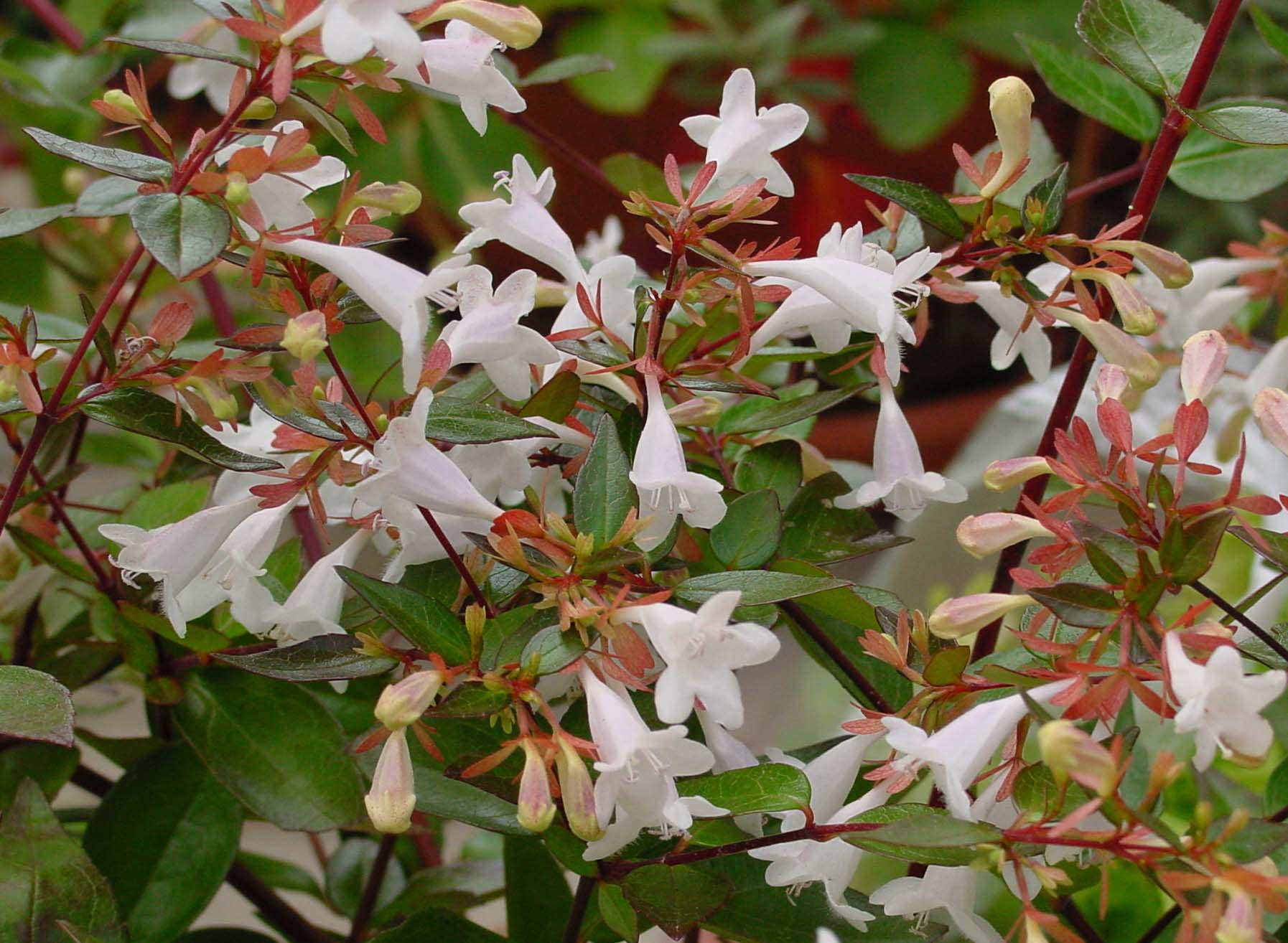
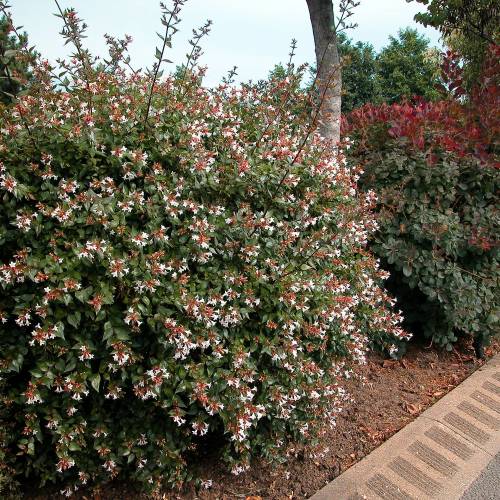
Botanical Name: Aucuba japonica


Botanical Name: Aucuba japonica
Common Name: Japanese laurel
Family: Garryaceae
Distribution/Origin: Japan
Leaf: large, glossy and green with yellow specks, elliptic-ovate
Bud: opposite
Flower: purply brown color, 5 petaled, blooms May-June, dioecious, loose cymes/panicles
Fruit/Seed: red drupe, poisonous
Stem/Bark: green, multi stemmed
Size: 3-16’ height, 5-8’ spread
Habit: dense, stiffly upright
Form: round
Soil conditions: well drained, acidic, rich and humusy
Moisture: moist
Sun: part sun, part shade
Exposure:
Landscape use: accent plant, mixed borders, screening, specimen plant, winter interest
Notes:




Botanical Name: Berberis aquifolium
Common Name: Oregon grape, Oregon grape-holly
Family: Berberidaceae
Distribution/Origin: western North America, naturalized in Britain
Leaf: pinnate venation, spiny leaflets, leathery, oblong, spine tipped teeth, compound
Bud: alternate, sessile
Flower: dense clusters, yellow flowers, racemes
Fruit/Seed: dark bluish black berries, clusters, dusty appearance, many seeds
Stem/Bark: thickened corky stems, inner bark and roots bright yellow, smooth grey-brown
Size: 3-6’ height, up to 5’ spread
Habit: upright, spreading
Form: oval, vertical
Soil conditions: average soils, light to medium, well drained
Moisture: dry to moist
Sun: full sun, part shade to part sun
Exposure: can be placed in full sun as long as plant is kept moist
Landscape use: low hedge, walls, mixed shrub border, security/barrier, winter interest, woodland margin
Notes:

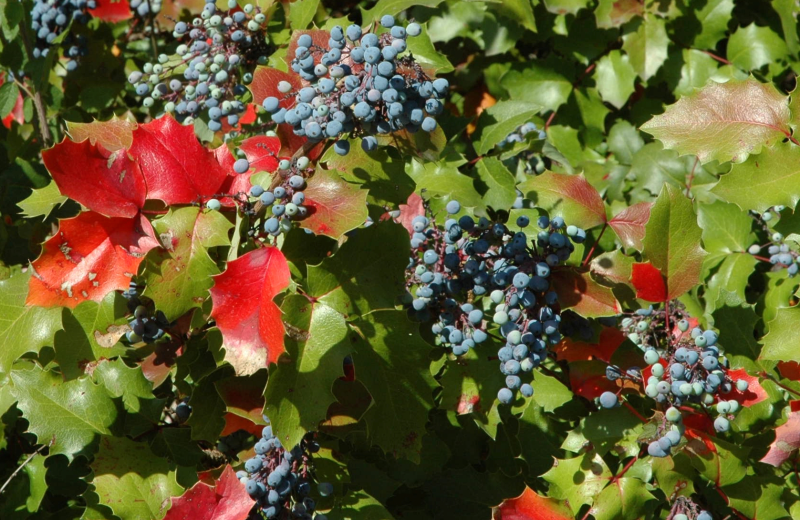


Botanical Name: Berberis x 'Charity'
Common Name: charity mahonia
Family: Berberidaceae
Distribution/Origin: garden origin
Leaf: odd pinnate, ovate-lanceolate leaflets, toothed margins, compound, leathery, glossy
Bud: sessile, alternate
Flower: densely clustered raceme, yellow blooms, sweet scent
Fruit/Seed: blue-black berries, many seeds
Stem/Bark: bark bright inner yellow, multi stemmed, spines, leafy stipules, furrowed brown to tan bark
Size: 3-5m height, 3-4m spread
Habit: arching, open, upright
Form: vase, oval, vertical
Soil conditions: acidic, humus rich, well drained
Moisture: low
Sun: deep shade, filtered shade, full sun, part shade
Exposure:
Landscape use: container planting, fall interest, filler, fragrance, group or mass planting, mixed border, screening, winter interest, woodland garden, tall background
Notes: used to be called Mahonia x charity

Botanical Name: Berberis nervosa
Common Name: longleaf mahonia
Family: Berberidaceae
Distribution/Origin: western North America, Mexico
Leaf: pinnately compound, lanceolate, spines, leathery texture, ovate shape, dark green to red
Bud: alternate
Flower: yellow racemes, sweetly scented
Fruit/Seed: blue to purple berries, clusters, edible
Stem/Bark: red stems, yellowish green bark
Size: 1-3’ height, 2-3’ spread
Habit: spreading
Form: mounding
Soil conditions: acidic, well drained, average
Moisture: moderate
Sun: full sun to partial shade
Exposure:
Landscape use: group or mass planting, reclamation, woodland margin
Notes:




Botanical Name: Choisya x dewitteana 'Aztec Pearl'
Common Name: Mexican mock orange
Family: Rutaceae
Distribution/Origin: garden origin
Leaf: palmately compound, narrow leaflets with smooth margins, oblong to obovate, trifoliate
Bud: opposite
Flower: showy, clusters of white 5 petalled flowers, citrus scent, corymbs
Fruit/Seed: aborted or absent
Stem/Bark: woody
Size: 6-13’ height, 6-13’ spread
Habit: dense
Form: round
Soil conditions: acidic, well drained
Moisture: moderate
Sun: full sun, partial shade
Exposure: protected
Landscape use: fragrance, hedgerow, mixed shrub border, specimen, spring interest
Notes:




Botanical Name: Ceanothus thyrsiflorus 'Victoria'
Common Name: California lilac, Victorian lilac, summer lilac
Family: Rhamnaceae
Distribution/Origin: south western US
Leaf: green ribbed stems, ovate to entirely crenate, simple, entire margins, lustrous surfaces
Bud: alternate
Flower: terminal lateral panicles, pale blue
Fruit/Seed: dark red to black capsule
Stem/Bark: smooth, lightly fissured, green to brown
Size: 9-16’ height, 13-16’ spread
Habit: bushy, upright, arching, twiggy, spreading
Form: round
Soil conditions: rocky or gravelly, well drained
Moisture: low, dry
Sun: full sun
Exposure:
Landscape use: accent plant, tall background, erosion control, screening, summer interest
Notes:




Botanical Name: Choisya ternata
Common Name: Mexican mock orange
Family: Rutaceae
Distribution/Origin: Mexico, south western US
Leaf: compound palmate, oblanceolate leaflets, entire margins, glossy green, trifoliate
Bud: opposite
Flower: perfect, cyme, white, sweet scent
Fruit/Seed: capsule
Stem/Bark: smooth, multi stemmed trunk, tan color
Size: 6-10’ height, 5-7’ spread
Habit: dense
Form: round
Soil conditions: acidic, well drained
Moisture: moderate
Sun: part sun part shade
Exposure:
Landscape use: accent plant, fragrance, group or mass planting, hedge row, mixed border, small garden space, woodland border
Notes: pungent basil-like scent when leaves are crushed. When leaves are held up to light distinctive oil glands are visible
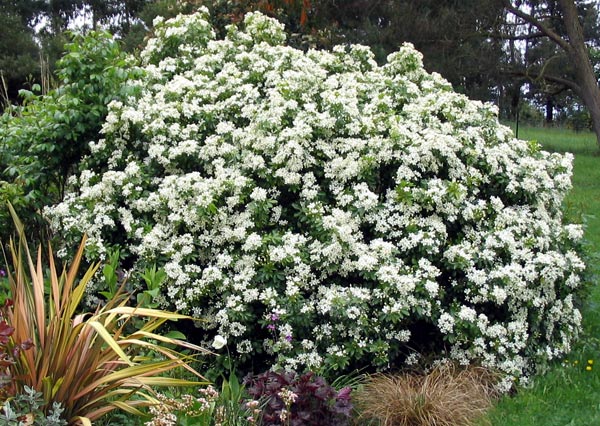



Botanical Name: Euonymus fortunei 'Emerald Gaiety' and E. 'Emerald n' Gold'
Common Name: emerald and gold wintercreeper
Family: Celastraceae
Distribution/Origin: garden origin
Leaf: simple, leathery texture, green with yellow/white margins, pink tint in winter, elliptic to ovate in shape, serrated margins
Bud: opposite
Flower: not showy, green to yellow
Fruit/Seed: brown capsule, orange fleshy seeds covered with arel
Stem/Bark: corky grey bark, adventitious roots
Size: 1-3’ height, 3-6’ spread
Habit: arching, dense, horizontal, spreading
Form: climbing, creeping, mat like, irregular, mounded
Soil conditions: well drained, average
Moisture: low
Sun: full sun
Exposure:
Landscape use: container planting, filler, erosion control, group or mass planting, winter interest
Notes:




Botanical Name: Euonymus japonicus
Common Name: Japanese spindle
Family: Celastraceae
Distribution/Origin: Asia
Leaf: oval in shape, finely serrated margins, waxy/lustrous surfaces, dark green
Bud: opposite
Flower: cyme, not showy, green
Fruit/Seed: white to pinkish capsule, orange seeds
Stem/Bark:
Size: 10-15’ height, 5-6’ spread
Habit: bushy, upright
Form: dense oval mound, stiff
Soil conditions: average, adaptable, well drained
Moisture: average
Sun: partial shade
Exposure: drought and salt tolerant, withstands heavy pruning
Landscape use: naturalized areas, sunny edge, dappled shade, hedge
Notes: all parts of plant are poisonous if ingested




Botanical Name: Leucothoe axillaris
Common Name: coast leucothoe, coastal doghobble
Family: Ericaceae
Distribution/Origin: USA
Leaf: simple, leathery, lustrous dark green surfaces, new growth is bronze-red, twisted and curved
Bud: alternate
Flower: pendulous/axillary clusters, white, inverted urn shape
Fruit/Seed: globular capsule
Stem/Bark: smooth, light brown
Size: 2-4’ height, 3-5’ spread
Habit: arching, spreading
Form: mounding
Soil conditions: average, well drained, acidic, organic
Moisture: medium
Sun: part sun
Exposure: can grow in full sun with adequate moisture, protected
Landscape use: hedge, rock garden, slope, border, foundation plant, underplanting
Notes: deer resistant (unless they’re really hungry)
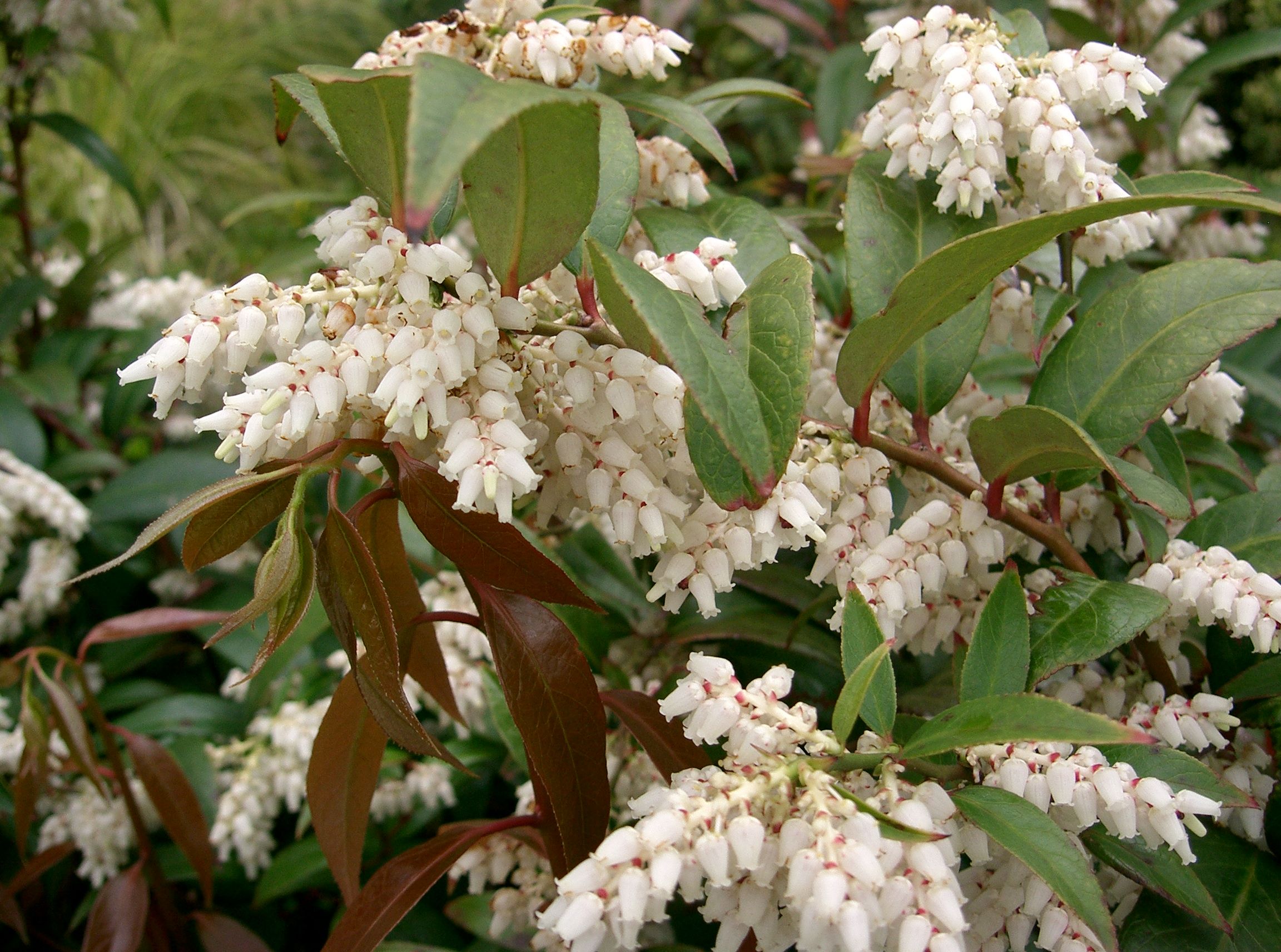



Botanical Name: Leucothoe fontanesiana 'Rainbow'
Common Name: rainbow leucothoe, doghobble
Family: Ericaceae
Distribution/Origin: garden origin
Leaf: rubbery texture, lanceolate, dark green mottled green and pink, serrate margins
Bud: alternate, leaf buds red, scale covered in leaf axils
Flower: white, urn shaped, terminal and axillary racemes
Fruit/Seed: brown capsules, insignificant
Stem/Bark: lightly fissured
Size: 2-4’ height, 3-6’ spread
Habit: multi stemmed, arching
Form: oval, horizontal, rounded
Soil conditions: acidic, well drained, average
Moisture: moderate
Sun: deep shade, filtered shade, part sun
Exposure:
Landscape use: mixed shrub border, woodland margin, filler
Notes:

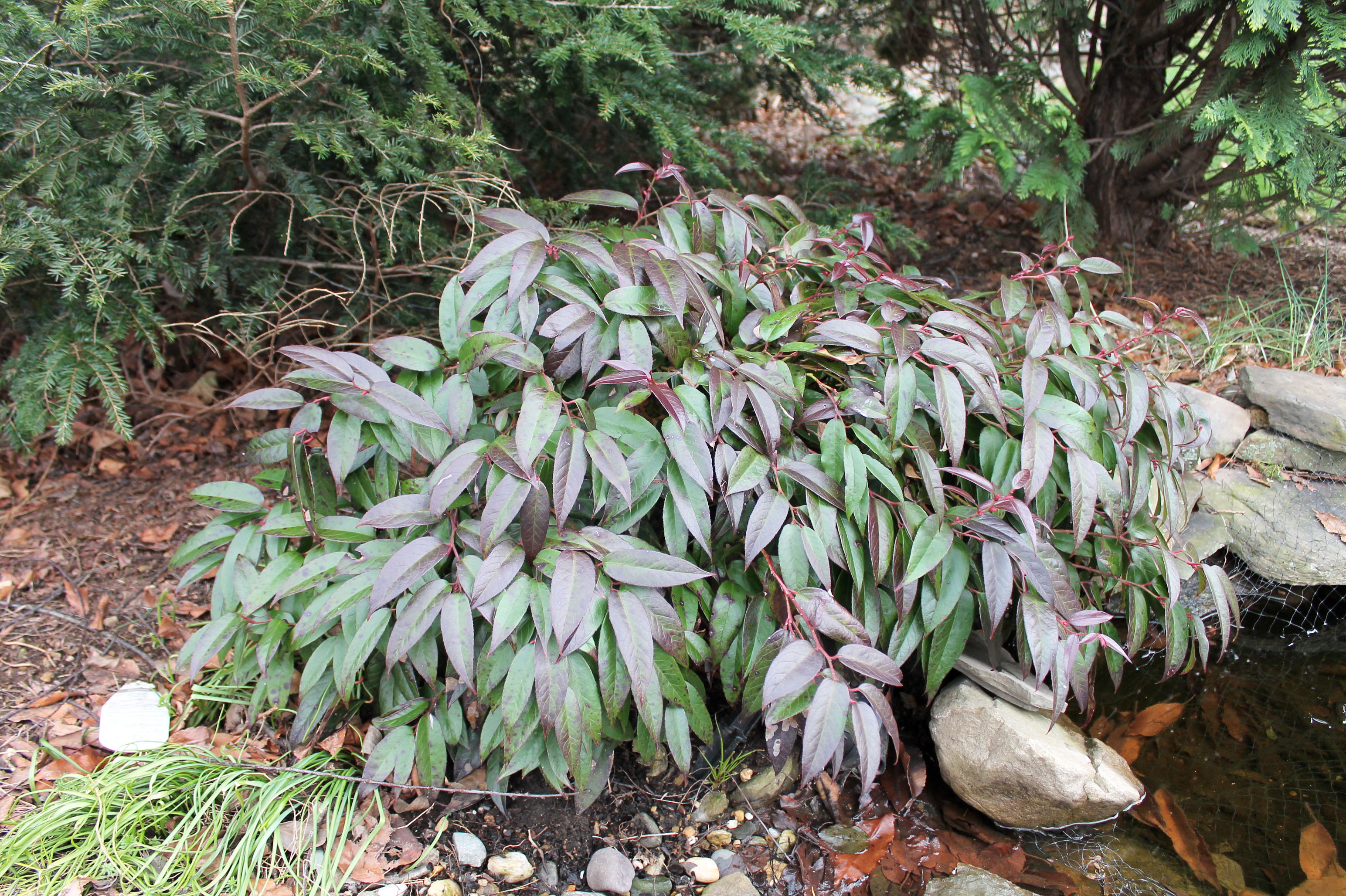


Botanical Name: Magnolia grandiflora
Common Name: southern magnolia, bull bay
Family: Magnoliaceae
Distribution/Origin: southeast US
Leaf: large, thick, glossy, dense brown pubescence on undersides, leathery, pinnate venation, elliptic to ovate in shape, entire margins
Bud: terminal reproductive buds are large fuzzy brown, alternate
Flower: thick petals, large, creamy white, perfect, solitary, 5 petaled, fragrant
Fruit/Seed: follicle of aggregate fruit, red
Stem/Bark: smooth, grey
Size: up to 32-50’ height, 20-30’ spread
Habit: dense, upright
Form: oval, vertical
Soil conditions: well drained, average
Moisture: moist
Sun: full sun, partial shade
Exposure: sheltered
Landscape use: wall side borders, low maintenance, architectural, large spaces, spring interest
Notes: beetle pollinated, hard heavy timber valued for furniture, very fragrant




Botanical Name: Pieris japonica
Common Name: lily of the valley shrub
Family: Ericaceae
Distribution/Origin: Japanese andromeda, Japanese pieris
Leaf: narrow elliptic, whorled at ends of branches, leathery, pinnate venation, glabrous surfaces, oblanceolate/obovate
Bud: alternate, spiraled
Flower: white, urn shaped, suspended from peduncle, floriferous racemes, white to pink, blooms March to April
Fruit/Seed: red to brown capsule
Stem/Bark: new growth is red, lightly fissured, multi stemmed trunk, grey to brown
Size: 3-7’ height, 5-7’ spread
Habit: dense
Form: oval, vertical
Soil conditions: acidic, well drained, humusy, rich
Moisture: moderate
Sun: filtered shade, full sun, part sun/shade
Exposure: best in sheltered locations from wind and hot sun
Landscape use: mixed shrub border, screening, small space, specimen, spring interest
Notes: poisonous if consumed by animals or humans. Brittle stems.




Botanical Name: Prunus laurocerasus
Common Name: English laurel, cherry laurel
Family: Rosaceae
Distribution/Origin: Europe
Leaf: glossy green, ovate-oblong, rounded tips and serrated margins, pinnate venation
Bud: alternate
Flower: funnel form racemes, white, fragrant, blooms April-May
Fruit/Seed: red to black drupes (Jul-Aug)
Stem/Bark: lightly fissured, brown to grey
Size: 20-30’ height, 20-30’ spread
Habit: dense, stiffly upright
Form: round
Soil conditions: acidic, well drained, fertile
Moisture: moderate
Sun: part sun/shade
Exposure: tolerant of drought and shade, often able to outcompete native plants hence its invasive status.
Landscape use: hedgerow, screening, large spaces, woodland garden, mass planting
Notes: leaves have almond scent when crushed. Considered invasive in some regions of Europe. Highly poisonous for humans (all parts).

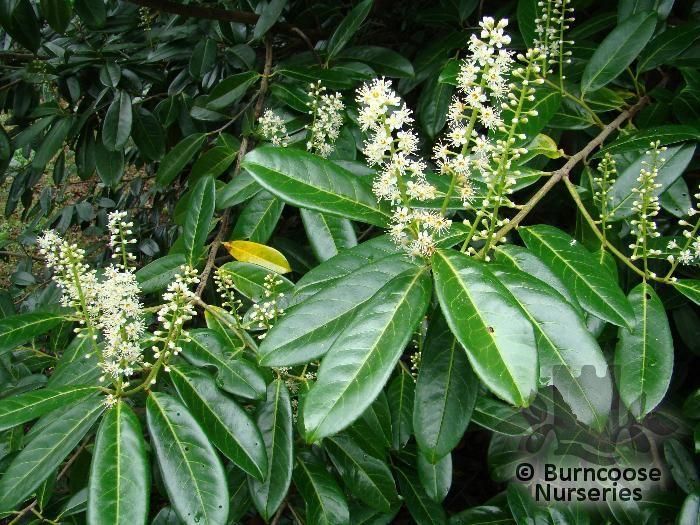
Botanical Name: Prunus laurocerasus 'Otto Luyken'
Common Name: Otto Luyken laurel
Family: Rosaceae
Distribution/Origin: Europe/garden origin
Leaf: glossy, rubbery texture, dark green, lanceolate to oblong, simple, entire margins
Bud: alternate, ovoid leaf buds
Flower: bottlebrush raceme, 5 petaled, many stamens, fragrant (bloom April-May)
Fruit/Seed: green to black drupe
Stem/Bark: smooth, green to brown
Size: 3-4’ height, 3-5’ spread
Habit: dense, spreading, upright
Form: round, vase
Soil conditions: acidic, well drained, fertile
Moisture: moderate
Sun: full sun, partial shade
Exposure:
Landscape use: group or mass planting, mixed shrub border, sheared hedge, small space
Notes: named after Otto Luyken, the original breeder of the cherry laurel.



Botanical Name: Prunus laurocerasus 'Zabeliana'
Common Name: Zabel laurel
Family: Rosaceae
Distribution/Origin: garden origin
Leaf: simple, leathery surfaces, lanceolate, entire to serrulate margins
Bud: alternate
Flower: white raceme
Fruit/Seed: blue to black drupe
Stem/Bark: smooth, grey to dark grey
Size: 3-4’ height, 7-10’ spread
Habit: spreading
Form: oval, horizontal
Soil conditions: acidic, well drained, fertile
Moisture: moderate
Sun: full sun, part shade/sun
Exposure:
Landscape use: group or mass planting, mixed borders, filler
Notes:




Botanical Name: Prunus lusitanica
Common Name: Portugal laurel
Family: Rosaceae
Distribution/Origin: Europe
Leaf: glossy, dark green, undulating serrated margin, leathery, soft/flexible, elliptic to ovate
Bud: alternate
Flower: floriferous white racemes
Fruit/Seed: blue to black drupe
Stem/Bark: smooth, dark grey
Size: 30-50’ height, 30-50’ spread
Habit: upright
Form: oval, vertical
Soil conditions: well drained, acidic, fertile
Moisture: moist
Sun: full sun to partial shade
Exposure:
Landscape use: hedgerow, screening, large spaces, naturalized areas
Notes: invasive, spread by birds
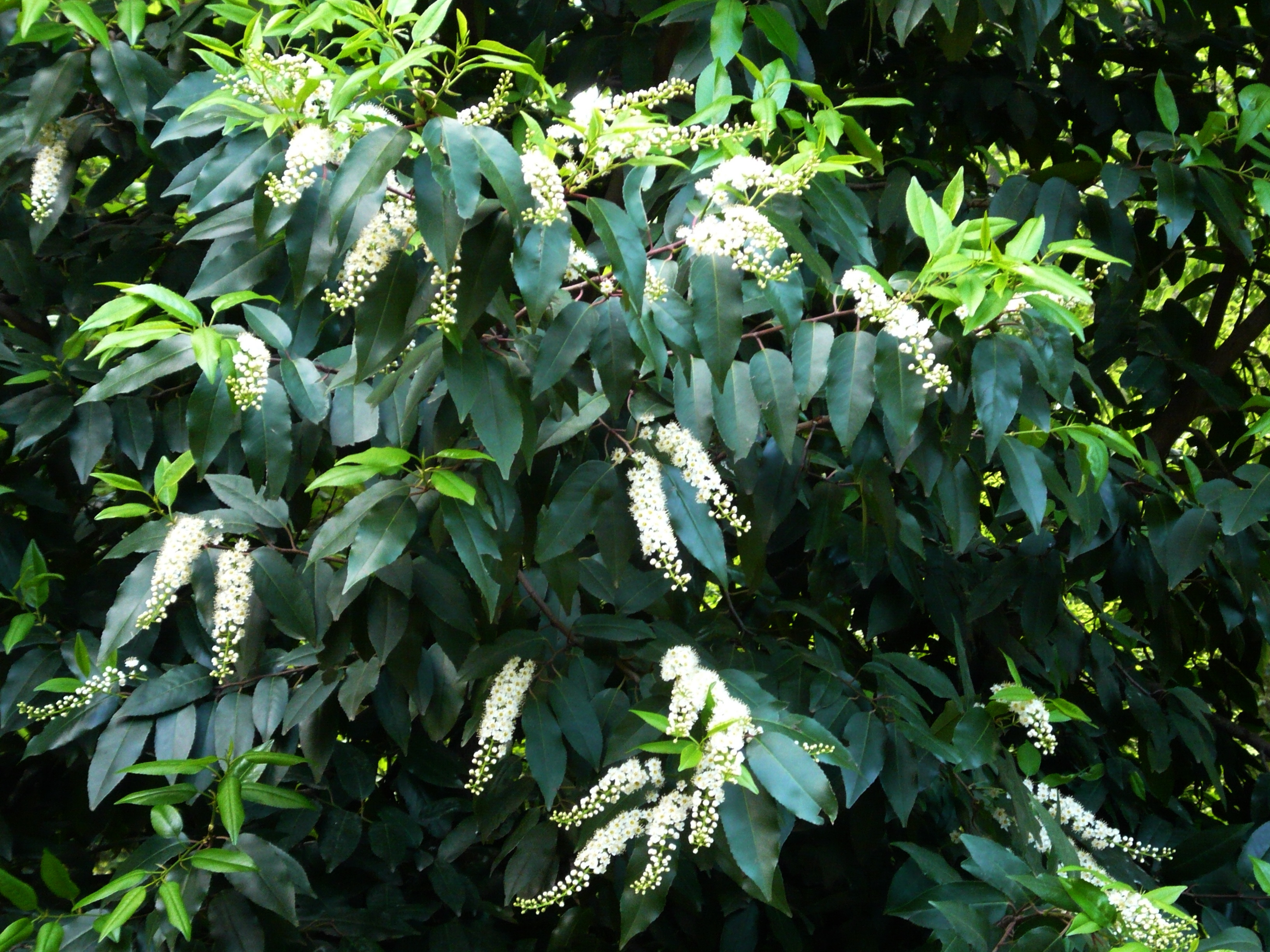



Botanical Name: Viburnum davidii
Common Name: David's viburnum
Family: Adoxaceae
Distribution/Origin: SE Asia
Leaf: simple, heavy palmate venation, leathery, glabrous surfaces, obovate to ovate, dentate to entire margins
Bud: opposite
Flower: corymb to tubular flat like cymes, pink to white
Fruit/Seed: metallic blue drupe
Stem/Bark: multi stemmed, red to brown
Size: 4-5.5’ height, 5-7’ spread
Habit: spreading
Form: mounded
Soil conditions: well drained, fertile, humus rich
Moisture: moderate
Sun: full sun, part shade/sun
Exposure:
Landscape use: borders, meridians, beds, filler, group or mass planting, small space, winter interest, woodland margin
Notes:
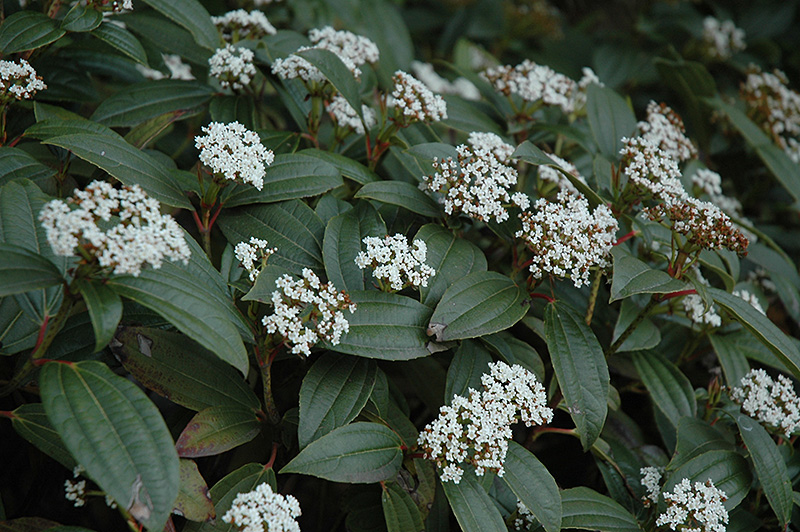



Botanical Name: Viburnum tinus
Common Name: Laurustinus
Family: Adoxaceae
Distribution/Origin: Europe, Mediterranean, North Africa
Leaf: ovate to elliptic, entire margin
Bud: opposite
Flower: dense cymes, white to pink blooms, small, bisexual, fragrant
Fruit/Seed: dark blue to black drupe
Stem/Bark: red stems, multi stemmed, reddish new growth, brown to grey in maturity
Size: 7-23’ height, up to 10’ spread
Habit: dense, bushy
Form: rounded crown
Soil conditions: average, well drained
Moisture: moist
Sun: part shade, filtered sun
Exposure: tolerant of winds, does not like maritime exposure
Landscape use: woodland garden, sunny edge, dappled shade, hedge
Notes:


No comments:
Post a Comment